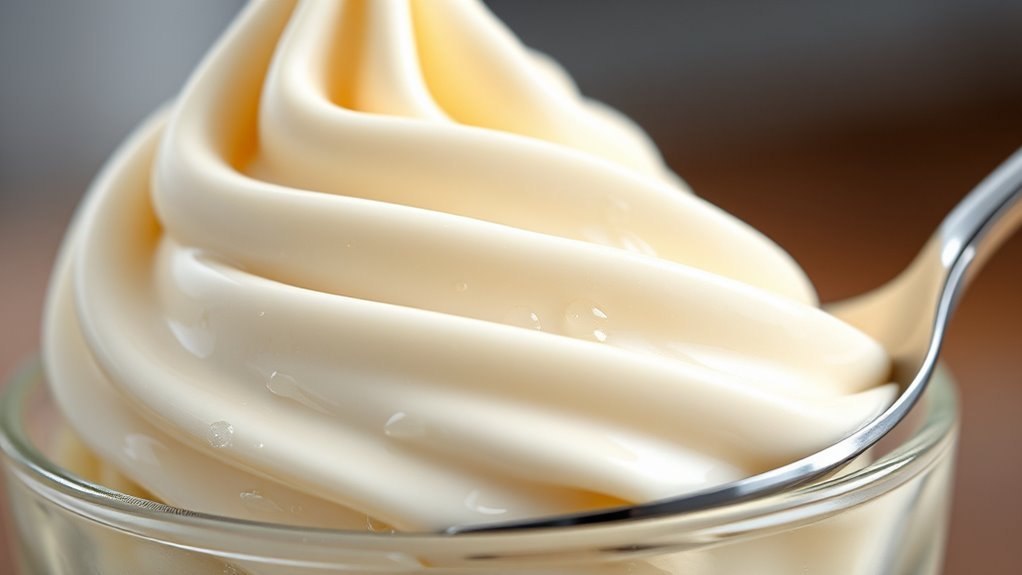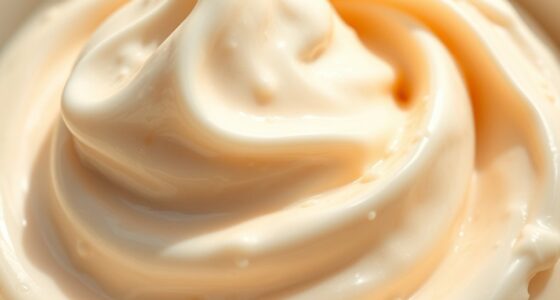Stabilizers, especially gums like guar or locust bean, keep your ice cream smooth by preventing ice crystals from forming and maintaining a creamy texture. They help improve viscosity, making each scoop easy to serve, while also ensuring consistent flavor distribution. Without these gums, your ice cream may become icy or separate. The best part? Continuing with this guide will show you how stabilizers truly keep your ice cream irresistibly smooth and delicious.
Key Takeaways
- Gums act as stabilizers by preventing ice crystal growth, maintaining a smooth and creamy texture.
- They improve viscosity and prevent separation in dairy-free and plant-based ice creams.
- Stabilizers enhance flavor distribution, ensuring consistent taste throughout the product.
- Gums improve scoop-ability, reduce melting rate, and extend shelf life of ice cream.
- They help create a uniform, indulgent mouthfeel, making ice cream enjoyable from first to last scoop.

Have you ever wondered how filmmakers keep their shots steady or how smartphones produce smooth videos? The same principles of stability apply to food, especially when it comes to ice cream. When you enjoy a scoop that’s perfectly smooth and creamy, stabilizers like gums play a crucial role. These natural or synthetic substances help keep the texture uniform, preventing ice crystals from forming and ensuring each bite is as delightful as the first. Stabilizers are particularly important in products that use dairy alternatives, such as almond or oat milk, where the absence of traditional dairy can affect texture. They help bridge the gap, creating a consistent mouthfeel and preventing separation or ice crystal growth that can ruin the experience.
In dairy-free ice creams, stabilizers become even more essential because these alternatives often have different fat and protein content compared to cow’s milk. Without stabilizers, the mixture might separate or develop an icy, gritty texture. Gums like guar gum or locust bean gum are commonly used because they effectively thicken the mixture and improve viscosity. This results in a creamier, more indulgent texture that mimics traditional dairy ice cream. Besides maintaining consistency, stabilizers also contribute to flavor enhancement. By controlling the ice cream’s structure, they allow flavors to be more evenly distributed, making every spoonful taste just as good as the first. They help deliver a balanced blend of sweetness, richness, and flavor notes, especially when incorporating ingredients like fruit purees or natural sweeteners.
You might not realize it, but stabilizers also improve the scoop-ability of ice cream, making it easier to serve and enjoy without it melting too quickly or sticking to the scoop. This is particularly important if you’re serving ice cream at parties or in restaurants, where presentation matters. Furthermore, stabilizers help extend the shelf life of the product, maintaining its quality over time. They prevent the formation of large ice crystals during storage, keeping the ice cream smooth and pleasant from the first scoop to the last.
Frequently Asked Questions
Are Stabilizers Safe for People With Allergies?
If you have allergy concerns, stabilizers can be safe, but always verify allergen labeling carefully. Some stabilizers come from common allergens like soy or gluten, so reading labels helps avoid reactions. Manufacturers are required to clearly identify allergens, making it easier to choose safe options. If you’re unsure, consult your healthcare provider or opt for products labeled as allergen-free to ensure your safety.
How Do Stabilizers Affect Ice Cream Flavor?
Imagine biting into a scoop of ice cream where every mouthful is perfectly smooth and bursting with flavor. Stabilizers subtly influence this experience by enhancing flavor retention and preventing ice crystals, which keeps the taste fresh. They also improve texture, making each spoonful creamy and consistent. So, stabilizers don’t overpower your flavor; instead, they work behind the scenes to amplify every delicious note and guarantee a satisfying, velvety texture.
Can Stabilizers Be Used in Homemade Ice Cream?
Yes, you can use stabilizers in homemade ice cream. You might try DIY stabilizer techniques like adding a small amount of gelatin, cornstarch, or xanthan gum to your recipes. For homemade stabilizer recipes, experiment with ingredients like agar-agar or egg yolks to improve texture and prevent ice crystals. Just start with small quantities, blend well, and adjust to achieve that smooth, creamy consistency you want in your ice cream.
Do Stabilizers Impact the Nutritional Value of Ice Cream?
Stabilizers can subtly impact the nutritional value of ice cream, but typically, their effect is minimal. They’re added in small amounts, so they usually don’t alter health considerations considerably. However, if you’re sensitive to certain gums or additives, it’s good to check labels. Overall, stabilizers help improve texture without compromising the nutritional quality, making your ice cream smoother and more enjoyable without major health concerns.
Are There Natural Alternatives to Commercial Stabilizers?
A stitch in time saves nine, so yes, there are natural alternatives to commercial stabilizers. You can use plant-based thickeners like chia seeds, flaxseed, or arrowroot powder, which act as natural emulsifiers and thickeners. These ingredients help maintain a smooth texture without additives, making your ice cream healthier and more wholesome. Give them a try for a natural, delicious treat that’s good for you and the environment.
Conclusion
So, next time you enjoy that silky scoop, remember stabilizers like gums are secretly working behind the scenes. Some say they prevent ice crystals and keep your ice cream smooth, but recent studies suggest they might also enhance flavor release. While the science is still evolving, one thing’s clear: stabilizers play a vital role in delivering that perfect, creamy texture you love. Without them, your favorite treat just wouldn’t be the same!








